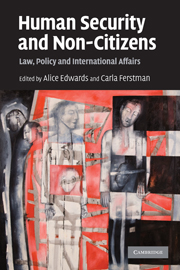Book contents
- Frontmatter
- Contents
- About the editors
- About the contributors
- Preface
- Acknowledgements
- Part I Human security, human rights and human dignity
- 1 Humanising non-citizens: the convergence of human rights and human security
- Part II Physical and legal security, armed conflict and refuge
- Part III Migration, development and environment
- Part IV National security and the ‘war on terror’
- Index
1 - Humanising non-citizens: the convergence of human rights and human security
Published online by Cambridge University Press: 17 February 2011
- Frontmatter
- Contents
- About the editors
- About the contributors
- Preface
- Acknowledgements
- Part I Human security, human rights and human dignity
- 1 Humanising non-citizens: the convergence of human rights and human security
- Part II Physical and legal security, armed conflict and refuge
- Part III Migration, development and environment
- Part IV National security and the ‘war on terror’
- Index
Summary
Introduction
Some of the most heated debates on security relate to presuppositions about what security is, what is being secured, the causes of insecurity, and how best to address insecurity. International relations theorists and policy experts have varying perspectives on these questions, which have evolved and have had changing levels of acceptance over time. Realists and neo-realists emphasise the state as the central referent of security, both as the lens through which security is understood, as well as the tool by which security is best maintained or restored. Liberal theorists recognise a wider set of values embedded in the concept of the state and state security, in the methods and means to address insecurity, and the actors involved. More critical constructivist scholars understand that the interests and identities of states are themselves constructed by the distribution of ideas and interests within the state-based system and this shapes a state's security interests and how these are conceived, and in turn impacts upon the actions necessary to ensure security. Feminists argue that traditional security discourse is flawed to the extent that it excludes women and other marginalised groups. Theorists belonging to the school of Critical Security Studies (CSS) have argued, moreover, that people, and not states, must be the referent objects of security and, as such, this school provides the closest theoretical underpinning for the human security paradigm.
- Type
- Chapter
- Information
- Human Security and Non-CitizensLaw, Policy and International Affairs, pp. 3 - 46Publisher: Cambridge University PressPrint publication year: 2010
- 7
- Cited by



